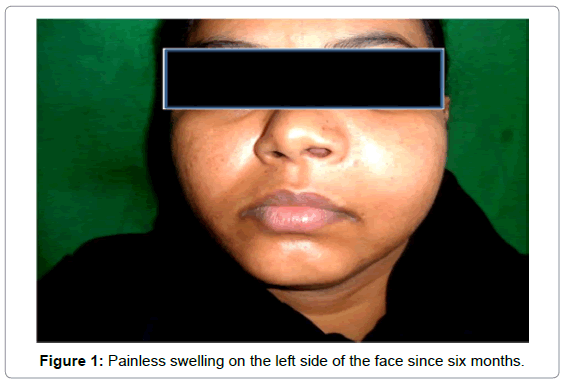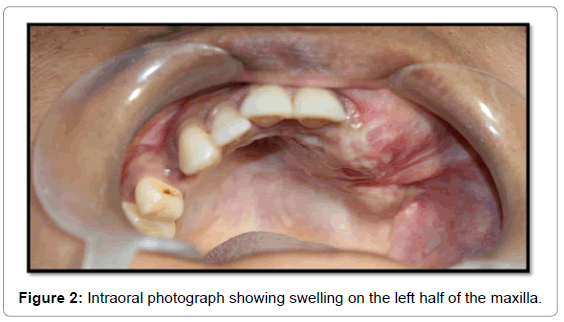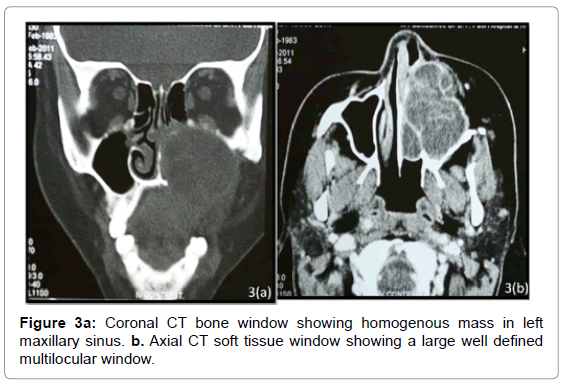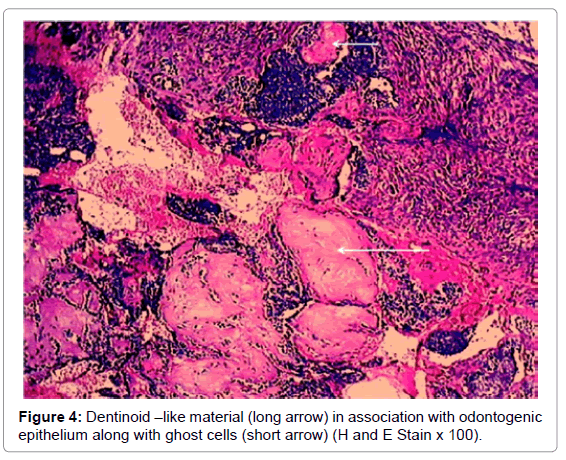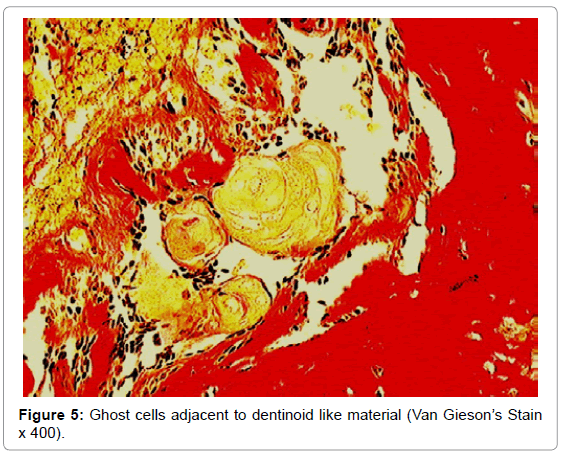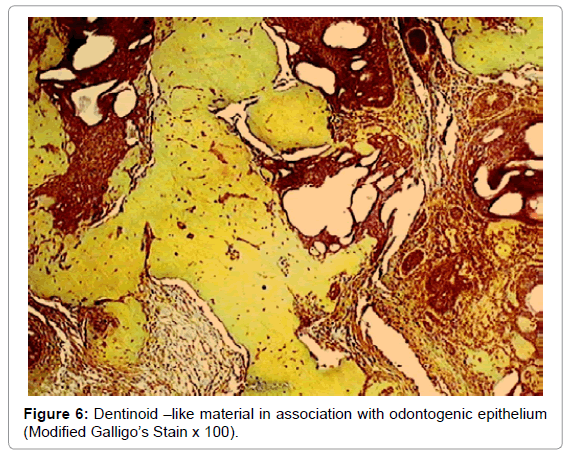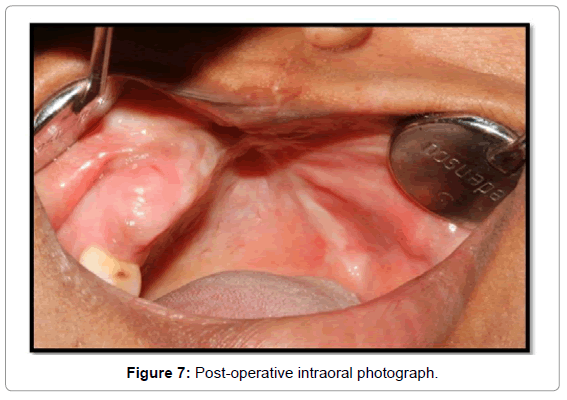Case Report Open Access
Hybrid Odontogenic Tumor with COC and Multiple Variants of Ameloblastoma-A Rare Case Report
Treville Pereira*, Avinash P Tamgadge, Sudhir Bhalerao and Sandhya Tamgadge
Department of Oral & Maxillofacial Pathology and Microbiology, Dr D Y Patil Dental College & Hospital, Sector 7, Nerul, Navi Mumbai, Maharashtra, India
- *Corresponding Author:
- Treville Pereira
Department of Oral & Maxillofacial Pathology and Microbiology
Dr D Y Patil Dental College & Hospital, Sector 7
Nerul, Navi Mumbai, Maharashtra, India
Tel: 919821281458
Fax: 912227709590
E-mail: trevillepereira@gmail.com
Received Date: February 25, 2014; Accepted Date: March 26, 2014; Published Date: April 02, 2014
Citation: Pereira T, Tamgadge AP, Bhalerao S, Tamgadge S (2014) Hybrid Odontogenic Tumor with COC and Multiple Variants of Ameloblastoma-A Rare Case Report. J Oral Hyg Health 2:126. doi: 10.4172/2332-0702.1000126
Copyright: © 2014 Pereira T, et al. This is an open-access article distributed under the terms of the Creative Commons Attribution License, which permits unrestricted use, distribution, and reproduction in any medium, provided the original author and source are credited.
Visit for more related articles at Journal of Oral Hygiene & Health
Abstract
Ameloblastomas do not generally show evidence of induction, however rare cases associated with odontome have been reported and are referred to as odontoameloblastoma. This article presents an unusual case of multiple histopathological variants of ameloblastoma with evidence of induction of dentinoid by tumor cells but without concomitant formation of enamel along with features of ghost cells. The lesion occurred on the left side of the maxilla in a 31-year old female. Case management has been described and implications are discussed.
Keywords
Adenoid ameloblastoma; Dentinoid; Ghost cells; Odontogenic tumor
Introduction
Odontogenic cysts and tumors comprise of a group of lesions that are rather diverse histopathologically because of their complexity and prolonged process of odontogenesis. In 1971, the WHO published its first internationally agreed classification of odontogenic tumors and cysts, entitled “Histological typing of odontogenic tumors and jaw cysts and allied lesions” which included the proposed criteria for designation, and a standard nomenclature. During the interim period, new variants and entities have undoubtedly emerged [1]. Odontogenic tumors composed of two or more distinct types of lesions are rare and unusual. As neoplastic and hamartomatous aberrations can occur at any stage of odontogenesis, combined features of odontogenic tumors may arise. Moreover, tumors which are classified into the group of epithelial tumors without odontogenic mesenchyme, like ameloblastoma and Adenomatoid Odontogenic Tumor (AOT), may show evidence of dentinoid induction. Ameloblastoma is the most primitive odontogenic tumor and although it is characterized by a wide variety of histological appearances, it does not generally show evidence of induction, with the exception of odontoameloblastoma. However, rare cases of ameloblastoma showing evidence of dentinoid induction by tumor cells but without concomitant formation of enamel are reported [2,3].
The so called Calcifying odontogenic cyst (COC) is the most elusive and controversial lesion. COC contains two entities: a cyst and a tumor. The latter has been called as dentinogenic ghost cell tumor, epithelial odontogenic ghost cell tumor, or odontogenic ghost cell tumor (OGCT). It is well known that the proliferating epithelium in COC shares several features with ameloblastoma. Clinically OGCT has been aggressive and locally destructive, very similar to the behavior of ameloblastoma. Ellis suggested that two features distinguish OGCTs from ameloblastomas. The first is ghost cells. These cells are an essential requisite for the diagnosis of OGCT, but they are occasionally seen in other odontogenic lesions such as odontoma, ameloblastic fibro odontoma, odontoameloblastoma, ameloblastic fibrodentinoma and glandular odontogenic cyst. A few ghost cells have also been found in simple ameloblastoma. The second distinguishing feature is dentinoid induction, but dentinoid may be present in conventional ameloblastoma- dentinoameloblastoma as described within the later section in this treatise [1]. This case reports a rare odontogenic tumor with similar histopathological features.
Case Report
A 30 year old female patient reported to the outpatient department with the chief complaint of a painless swelling on the left side of the face since six months. Initially the swelling was small and gradually attained the present size of 6×2 cm. Numbness was associated with the swelling. Heaviness and stuffiness on the left cheek and left side of the nose was also noted. Patient complained of a change in her voice over a period of time. On examination, a diffuse extraoral swelling was present on the left side of the face approximately 6×2 cm in size. Anteroposteriorly, the swelling extended from the ala of the nose to the tragus of the ear. Superioinferiorly, the swelling extended from the infraorbital region to the angle of the mouth (Figure 1). Intraorally, there was bicortical expansion of the maxilla extending from the incisor area to the molar area. All the teeth on the left side of the maxilla were absent other than the central incisor of the same side (Figure 2). Coronal CT bone window showed a large homogenous soft tissue mass occupying the left maxillary sinus encroaching into the left nasal cavity and ethmoid sinus. Anterior wall of maxillary sinus, the palatine process and zygomatic process of the left side are not seen. The axial CT in soft tissue window showed a large homogenous encapsulated mass with multiple septae occupying the entire maxillary sinus and encroaching into the nasal cavity. Anterior wall of maxillary sinus and zygomatic process are missing (Figure 3a and 3b).
Patient had a past dental history of treatment for a similar swelling 6 years back. The histopathological diagnosis was that of an AOT. It recurred three years later and the histopathology report revealed it to be a follicular ameloblastoma.
Segmental resection of the left maxilla was done and submitted for pathologic examination.
Histopathological Report
Haematoxylin and eosin stained section showed a cystic lining composed of odontogenic epithelium. The epithelium showed low cuboidal to flattened squamous type cells containing small and oval basophilic nuclei. Extending from the lining was an arrangement of cuboidal basophilic cells with occasional stellate reticulum like cells that formed microcystic spaces or pseudocysts. The pseudocysts were lined by cuboidal cells yielding an adenoid cribriform pattern. The cells which were ameloblasts like showed reversal of polarity and were arranged in a pattern resembling a plexiform ameloblastoma. Certain areas showed epithelial nests containing basaloid cells with nuclear polarization. Few areas showed dysplastic dentin formation but did not show the evidence of any dentinal tubules. In addition, collection of ghost cells suggestive of COC was observed (Figure 4).
Discussion
Elaborate review of English language literature and the search for published cases revealed that there are 13 reported cases of odontogenic tumors that have histopathological features similar to ameloblastoma with formation of hard tissue resembling dentinoid.
Upon reviewing the case reports, an observation of a wide range of age distribution from 4 years and 11 months to 42 years, with a mean age of 26.5 years was noted. Out of 13 cases, 8 were male and 5 were female, with a male: female ratio of 2:1.2.The most common site for occurrence was the posterior mandible. Tajima et al. [4] reported a case in maxillary antrum, whereas Ghasemi-Moridani and Yazdi [5] reported one case each located in the posterior right side of the maxilla. In the present case, the patient was a 30 year old female. The age was more than the mean age of occurrence. The lesion was located in the posterior region of maxilla which is slightly uncommon. Radio graphically, most of the lesions showed unilocular radiolucency. In a review of the previously reported cases, 12 cases showed a unilocular radiolucency and one showed a radio-opaque lesion. In the present case, the floor of the maxillary sinus was not traceable.
From the histopathological features, a diagnosis of Hybrid odontogenic tumor was made. The histopathological features of this composite odontogenic tumor are varied in various cases reported in the literature with hard tissue formation. The cases reported by Tajima et al. [4], Takeda [6], Matsumoto et al. [7] ,Orlowski et al. [8], Ghasemi-Moradani and Yazdi [5] and Dunlap and Fritzlen [9] showed histopathological features of adenomatoid odontogenic tumor and ameloblastoma, most commonly plexiform type.
The case reported by Slabbert et al. [10] showed features of only ameloblastoma. In the present case histopathological features showed plexiform type of ameloblastoma along with basaloid features and adenoid pattern. The ameloblast like cells showed reversal of polarity and were arranged in plexiform pattern (Figure 4). The other authors reported an inductive phenomena or a hard tissue formation with dentinoid like material. In the present case, a unique histological feature was the evidence of ghost cells which was positive for Van Geisons stain (Figure 5). Modified Galligo’s staining was performed to confirm the presence of dentinoid (Figure 6). Congo red staining was performed to exclude the presence of amyloid which may be a feature of AOT. Takeda [6] reported formation of bone whereas Dunlap and Fritzlen [9] and Tajima et al. [4] described the formation of enamel matrix. This may suggest the possibility that neoplastic cells of pure epithelial tumors are involved in the synthesis of hard tissue.
The prognosis of this composite odontogenic tumor is determined by the treatment provided. The presence of multiple histological components in a lesion begs the question of how a combined lesion should be treated. Wide local resection is the treatment of choice for these tumors. In our case, surgical resection of left side of maxilla was performed and the patient was kept under follow up. There was no sign of recurrence 6 months post operatively (Figure 7).
Conclusion
Hybrid Odontogenic lesions are rare, displaying two or more histopathological patterns. Data on behavior of these lesions is scarce since they are not commonly reported and they do not fit well into the current diagnostic taxonomy.
The case reported here is unique in that it is a hybrid neoplasm with three histopathological features of ameloblastoma i.e. plexiform, basaloid and adenoid pattern along with ghost cells suggestive of COC. Further, the nature of hard tissue, dentin or dentinoid like material in these lesions is the result of a metaplastic process or represents a true inductive phenomenon that is yet to be clarified.
References
- Ide F, Horie N, Shimoyama T, Sakashita H, Kusama K (2001) So - called Hybrid Odontogenic Tumors: Do they really exist? Oral Med Pathol 6: 13-21.
- Evans BL, Carr RF, Phillipe LJ (2004) Adenoid ameloblastoma with dentinoid: a case report. Oral Surg Oral Med Oral Pathol Oral RadiolEndod 98: 583-588.
- Reichart PA, Philipsen HP (2004) Adenomatoidodontogenic tumor. In: Allied Lesions (Eds.), Odontogenic Tumors, Quintessence Publishing Co. Ltd, London, pp-105.
- Tajima Y, Sakamoto E, Yamamoto Y (1992) Odontogenic cyst giving rise to an adenomatoidodontogenic tumor: report of a case with peculiar features. J Oral MaxillofacSurg 50: 190-193.
- Ghasemi-Moridani S, Yazdi I (2008) Adenoid ameloblastoma with dentinoid: a case report. Arch Iran Med 11: 110-112.
- Takeda Y (1994) So-called "immature dentinoma": a case presentation and histological comparison with ameloblasticfibrodentinoma. J Oral Pathol Med 23: 92-96.
- Matsumoto Y, Mizoue K, Seto K (2001) Atypicalplexiformameloblastoma with dentinoid: adenoid ameloblastoma with dentinoid. J Oral Pathol Med 30: 251-254.
- Orlowski WA, Doyle JL, Salb R (1991) Uniqueodontogenic tumor with dentinogenesis and features of unicysticplexiformameloblastoma. Oral Surg Oral Med Oral Pathol 72: 91-94.
- Dunlap CL, Fritzlen TJ (1972) Cystic odontoma with concomitant adenoameloblastoma (adenoameloblasticodontoma). Oral Surg Oral Med Oral Pathol 34: 450-456.
- Slabbert H, Altini M, Crooks J, Uys P (1992) Ameloblastoma with dentinoid induction: dentinoameloblastoma. J Oral Pathol Med 21: 46-48.
Relevant Topics
- Advanced Bleeding Gums
- Advanced Receeding Gums
- Bleeding Gums
- Children’s Oral Health
- Coronal Fracture
- Dental Anestheia and Sedation
- Dental Plaque
- Dental Radiology
- Dentistry and Diabetes
- Fluoride Treatments
- Gum Cancer
- Gum Infection
- Occlusal Splint
- Oral and Maxillofacial Pathology
- Oral Hygiene
- Oral Hygiene Blogs
- Oral Hygiene Case Reports
- Oral Hygiene Practice
- Oral Leukoplakia
- Oral Microbiome
- Oral Rehydration
- Oral Surgery Special Issue
- Orthodontistry
- Periodontal Disease Management
- Periodontistry
- Root Canal Treatment
- Tele-Dentistry
Recommended Journals
Article Tools
Article Usage
- Total views: 15927
- [From(publication date):
May-2014 - Jul 13, 2025] - Breakdown by view type
- HTML page views : 11194
- PDF downloads : 4733

